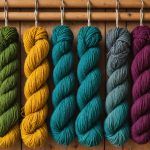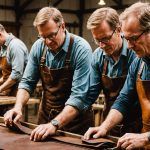Overview of British Wool Dyeing Workshops
Engaging in local crafts can provide unique insights into a region’s culture and traditions. In British wool dyeing workshops, participants get an opportunity to delve into the intricate art of transforming wool into vibrant hues. These workshops emphasize interactive and hands-on experiences that allow attendees to gain practical skills in a supportive environment.
Participants are introduced to various techniques used in wool dyeing, each with its own creativity and skill level. From using natural substances like plants and minerals to employing synthetic options for more precise colouration, both methods have their merits. While the creative process is rewarding, understanding the materials involved and how they react during the dyeing process is essential for achieving desired results.
Also read : Uncover Somerset’s Hidden Gems: Dive into the Heart of Traditional British Cider Craftsmanship
Tourism plays a significant role in supporting these traditional crafts. By drawing attention to such workshops, tourists can actively contribute to preserving and revitalising local heritage. Craft tourism not only stimulates local economies but also fosters an appreciation of artisanal skills.
Overall, British wool dyeing workshops serve as a bridge connecting people to the cultural narratives of British wool and its rich dyeing traditions, making it an enriching activity for those passionate about crafts.
In parallel : Unlock the Secrets of Traditional British Leather Tanning: Hands-On Workshops for Enthusiasts
Popular Workshops and Locations
Embarking on a journey to explore wool dyeing workshops often leads enthusiasts to some of the United Kingdom’s most picturesque and historically rich locales. Renowned for their emphasis on preserving traditional dyeing techniques while embracing modern creativity, these workshop locations offer immersive and inspiring crafting experiences.
In the scenic Lake District, for instance, participants can experience the tranquility of the landscape, while mastering unique dyeing techniques from seasoned artisans. Similarly, the bustling city of Edinburgh provides a vibrant backdrop, where workshops delve into the confluence of history and innovation in wool dyeing practices.
Prominent workshop providers like the Yorkshire Wool Heritage and the Scottish Craft Academy stand out for their well-designed programs and expert guidance. Yorkshire Wool Heritage, for example, focuses on sustainable dyeing practices using locally-sourced materials, whereas the Scottish Craft Academy offers courses blending cultural narratives with practical skills.
When selecting a workshop, tourists should consider their personal interests—be it ecological sustainability, historical patterns, or artistic innovation. It’s wise for participants to choose based on the workshop’s specialties, as engaging with these experts allows for a richer understanding of the craft and an unforgettable experience.
Techniques and Materials Used in Wool Dyeing
Engaging in wool dyeing techniques unveils a fascinating world filled with creative and practical elements. The choice between natural and synthetic dyes is a pertinent aspect, each offering distinct advantages. Natural dyes, often derived from plants, fruits, and minerals, provide eco-friendly results rich in subtle variations and historical relevance. On the other hand, synthetic dyes enable a more vibrant and consistent colour, catering to precision in design.
Natural vs Synthetic Dyes
Benefits of natural dyes include their sustainable nature and ability to produce muted, earthy tones that wear beautifully over time. However, their colours may be less predictable due to the varying chemical composition of natural sources. Synthetic dyes, in contrast, are celebrated for stability and clarity of shade, making them a favourite for specific artistic expressions.
Equipment and Materials Required
The dyeing process is an intricate dance of preparation and execution, requiring essential tools such as dye vats, mordants, and measuring instruments. These facilitate adhesion between dye and fibres. Equip participants with knowledge of these materials and their roles, critical for achieving harmonious results in every creation.
Step-by-Step Dyeing Process
Understanding the wool dyeing process involves preparing the wool, applying the dye, and setting it. Embracing these steps enhances adaptability, refinement, and appreciation of this age-old craft.
Workshop Schedules and Skill Levels
Participating in British wool dyeing workshops can be a rewarding experience for individuals of all skill levels. Understanding the workshop schedules is vital for making the most of these opportunities. Many workshops are available both seasonally and all-year-round, allowing participants to plan their visits according to personal and logistical preferences.
Workshops cater to varying skill levels, ensuring there’s something for beginners, intermediates, and advanced enthusiasts alike. Beginner workshops often focus on foundational techniques and basic concepts, ideal for those just starting their wool dyeing journey. Intermediate workshops delve deeper into technique refinement and exploring more complex patterns. For those with advanced skills, workshops may showcase experimental methods and intricate designs, challenging even seasoned artisans.
Booking a workshop can be straightforward. Early booking is recommended, especially for popular sessions during peak tourist seasons. Preparing for a workshop entails understanding any prerequisites, bringing appropriate materials, and wearing suitable attire. By familiarizing oneself with the schedule and skill requirements, participants can enhance their learning experience and develop a deeper appreciation for the artistry involved in British wool dyeing.
Testimonials and Experiences
Personal experiences in British wool dyeing workshops often lead to transformative and memorable learning journeys. Participants frequently highlight the enriching nature of these interactive sessions, where the hands-on experiences make the process not just educational, but genuinely enjoyable. Many testimonials praise the supportive atmosphere and expertise of the instructors, noting how their guidance and passion for the craft make every moment worthwhile.
Success stories emerge as individuals narrate their growth in confidence and skill through practical engagement. From learning rudimentary techniques to mastering more complex patterns, these experiences underscore the value of perseverance and creativity. Participants appreciate the opportunity to connect with fellow enthusiasts, exchanging ideas and feedback that enhance their understanding of the craft.
Hands-on experiences are often cited as pivotal in cementing knowledge and inspiring further exploration in wool dyeing. Such tales of personal growth and satisfaction serve as compelling endorsements for future visitors. Prospective tourists can glean valuable insights from these accounts, helping them to make informed decisions when choosing a workshop that aligns with their personal interests and aspirations. By learning from others’ encounters, one can better prepare and set realistic goals for their own creative journey.
Cultural Context of British Wool Dyeing
The rich cultural history of British wool dyeing serves as a testament to the United Kingdom’s long-standing tradition of textile artistry. For centuries, wool has been a cornerstone of British economic and social life, deeply interwoven with the nation’s identity. Historical significance is apparent as wool was one of Britain’s key exports, driving not just commerce but also technological innovation in textile production.
Regional variations in dyeing practices highlight the diversity of the craft across the UK. Each area often boasts unique techniques that reflect local resources and cultural influences. For instance, the earthy tones of the Lake District are achieved through natural dyes sourced from indigenous flora, while urban centres might experiment more with synthetic solutions to push artistic boundaries.
The influence of modern trends adds an intriguing layer to these traditional dyeing techniques. Contemporary artisans merge historical methods with current fashion and sustainability demands, which results in a colourful tapestry where past and present coalesce.
Tourists engaging with wool dyeing workshops gain a unique glimpse into this cultural tapestry, offering a deeper appreciation of how these traditional practices continue to evolve and flourish in modern times.
Tips for Tourists
Tourists looking to maximize their workshop experiences will find that a bit of preparation goes a long way. Approaching your workshop with the right mindset and equipment can transform a good experience into a great one.
Best Practices for Attending Workshops
- Engage Actively: Initiate conversations with instructors and fellow participants. Your curiosity can lead to deeper insights.
- Ask Questions: Don’t shy away from queries; your instructor is there to deepen your understanding.
What to Bring and Wear
Comfort is key. Wear comfortable clothing that you don’t mind getting stained, as dyeing can be messy. Bringing an apron might also be a prudent choice to protect your attire. Ensure sturdy, closed-toe shoes for protection.
Consider bringing a notebook and camera to document your learning process. This record can be a valuable reference for your future creations at home.
Engaging with Instructors and Local Artisans
Building rapport with your instructors and local artisans can be incredibly enriching. These artisans possess a wealth of knowledge about British wool dyeing and its regional nuances. By engaging with them actively, you’re not only enhancing your learning but also gaining insights that will help you appreciate the intricacies of this cherished craft.








